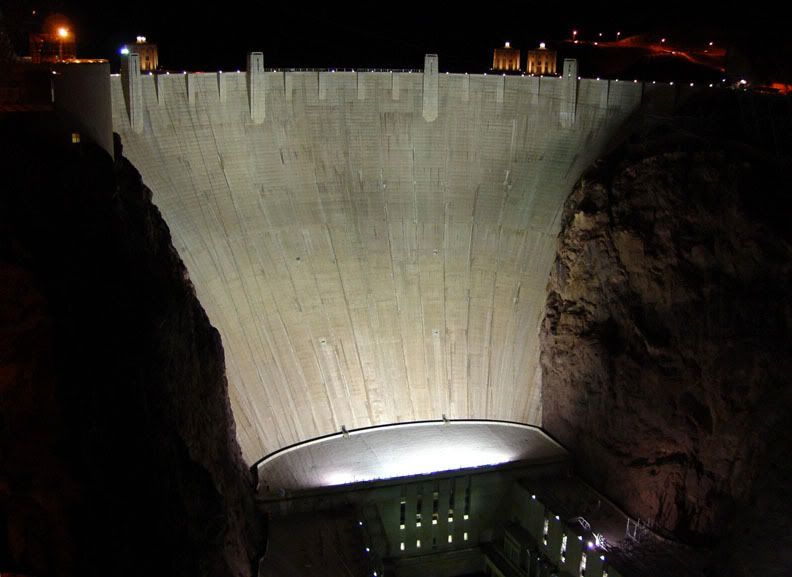
Posted on 03/31/2012 10:24:17 AM PDT by DogByte6RER
Who is buried in the Hoover Dam?
The Hoover Dam is one of the most phenomenal structures in modern history. This 1244 feet long, 660 feet thick, and 726 feet high concrete behemoth holds back so much water that it deformed the earth's crust and caused 600 small earthquakes in the decade after its construction.
Over 100 workers died constructing the Hoover Dam — and legend has it, some of them are buried within its concrete facade. Is there anything to these rumors?
An enormous number of deaths -
Over 100 people died in the construction of the Hoover Dam. Of those, 96 are identified as official "industrial fatalities", allowing the deceased's family to obtain compensation. Not included in the 96 are individuals who died from from pneumonia, a diagnosis now believed to be a cover for exposure to high levels of carbon monoxide.
Those who died of pneumonia often worked with gasoline powered equipment in a 140 °F, poorly ventilated area. Claiming pneumonia as the cause of death allowed Six Companies, the body governing this massive construction undertaking, to pursue a loophole preventing the payment of death benefits to families. Interestingly, no locals died of pneumonia during this time.
Forming the Massive Concrete Blocks that made up the Hoover Dam -
To build the dam, enormous seven foot deep and seven foot wide buckets poured concrete into square and rectangular forms ranging from 25 by 25 feet to 25 by 60 feet.
Depending on the square-footage of the block needed, the concrete level would rise two to six inches after each pour, making it rather difficult to lose a worker in a small increase in depth. Falling into the concrete might become an issue, but the workers could easily be extracted before the concrete hardened.
Decaying bodies are an architectural issue -
If a body did make its way into the Hoover Dam, the point of burial would quickly become a weakness in the structural integrity of that particular concrete block.
A human body is less structurally sound than the same volume of concrete. And if the body experienced any sort of decay, an air pocket could form around the body, further decreasing the stability of the weak point. Both situations would lead to a considerable six foot long, two foot wide weak spot in the dam, and a major problem when trying to hold back millions of gallons of water.
In 1933, W.A. Jameson found himself on the wrong end of a tumult of recently poured concrete. When a concrete form gave way, the wet concrete slid down the side of the Hoover Dam, covering Anderson and at least one other worker. Anderson did not survive. Sixteen hours after the fatal accident, workers removed his body from the site.
Workers continue to speak of buried bodies -
Those constructing the Hoover Dam not only failed to squash rumors of individuals buried inside during construction, but often exacerbated the tales.
In the mid-1980s, Todd King, a University of Nevada Professor, conducted interviews with several individuals who worked on the Hoover Dam to learn the truth behind their accounts. Though some of the stories of burial told by the elderly gentlemen sounded plausible to King, not one of the workers interviewed witnessed a person purposefully buried amidst the construction of the Hoover Dam.
Six bodies buried in Montana's Fort Peck Dam -
While it seems like no one is buried in the Hoover Dam, a 1938 structural failure caused thirty-four workers to be buried in the debris of Montana's Fort Peck Dam. Eight of the thirty-four trapped workers died in the collapse. Recovery workers later located two of the eight bodies, with six bodies still entombed inside the dam today.
Structural integrity of the dam aside, it is eerily romantic to imagine that some of the deceased found their final resting place inside of the structure they worked so hard to create. Though no one is permanently buried inside the Hoover Dam, rumors of this fate is not unusual due to its enormous size and the sheer number of deaths associated with the dam's construction.
You are an engineer and you are asking me?
Does the dome hold back 16 million acre feet of water? Does the dome take a constant traffic load including vibrations? Is the dome exposed to hot and cold extremes?
The dome material actually consists of lite weight aggregate which is supported by granite (stone) columns but of course you already knew that. Many (older) Roman roads and aqueducts still standing and some still in use.
Go back your trains.
Beautiful dam and art work.
Disclaimer: Opinions posted on Free Republic are those of the individual posters and do not necessarily represent the opinion of Free Republic or its management. All materials posted herein are protected by copyright law and the exemption for fair use of copyrighted works.